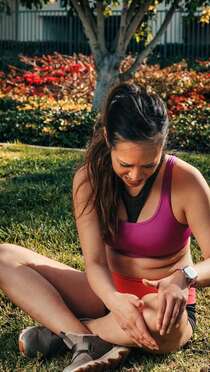Knee pain with increased exercise
Knee pain, particularly anterior and/or prepatellar knee pain, is a common condition seen in our clinics. Runners are very susceptible, as are those between the ages of 30 and 50 who start out on a new or modified exercise program. We find this tends to happen more frequently in the warmer months than other times throughout the year.
Some Common Symptoms
- pain with squatting or lunging
- difficulty with stairs (ascending or descending)
- pain after sitting with bent knees for prolonged periods of time
- trouble getting out of a chair
- increased pain with prolonged walking or running, even on a treadmill
- gradual worsening of swelling or weakness
Contributing Factors
These can include poor movement patterns when running or squatting; muscle imbalances between the quadriceps, hamstrings, gluteals, calves or iliotibial bands; poor biomechanics, particularly starting with over pronating or “flat” feet. These factors may have been present for a long time, but have only started to cause problems when the person increases exercise volume or intensity.
Tips to help?
- Ice the knee(s) for 15 to 20 minutes after each workout/run or work day;
- Decrease the incline on the treadmill, or try to walk on flat areas instead of hills;
- Decrease the depth of squats or lunges to decrease retropatellar forces;
- Wear good, supportive shoes with arch support for any exercise, especially walking or running.
If there is any concern that the above tips may not be enough, or that there may be more than just a niggling pain, the patient should be referred to a physiotherapist for a thorough assessment and treatment. All of our therapists here at The Physio Nook are very capable of managing knee injuries.
I hope this summary will help you or someone you know. As always, we are here at The Physio Nook to help out with any musculoskeletal disorders you may have, knees or otherwise! Feel free to call us, email, or drop in for a great service.
Paul Woodward
Principal Physiotherapist
The Physio Nook.
- pain with squatting or lunging
- difficulty with stairs (ascending or descending)
- pain after sitting with bent knees for prolonged periods of time
- trouble getting out of a chair
- increased pain with prolonged walking or running, even on a treadmill
- gradual worsening of swelling or weakness
Contributing Factors
These can include poor movement patterns when running or squatting; muscle imbalances between the quadriceps, hamstrings, gluteals, calves or iliotibial bands; poor biomechanics, particularly starting with over pronating or “flat” feet. These factors may have been present for a long time, but have only started to cause problems when the person increases exercise volume or intensity.
Tips to help?
- Ice the knee(s) for 15 to 20 minutes after each workout/run or work day;
- Decrease the incline on the treadmill, or try to walk on flat areas instead of hills;
- Decrease the depth of squats or lunges to decrease retropatellar forces;
- Wear good, supportive shoes with arch support for any exercise, especially walking or running.
If there is any concern that the above tips may not be enough, or that there may be more than just a niggling pain, the patient should be referred to a physiotherapist for a thorough assessment and treatment. All of our therapists here at The Physio Nook are very capable of managing knee injuries.
I hope this summary will help you or someone you know. As always, we are here at The Physio Nook to help out with any musculoskeletal disorders you may have, knees or otherwise! Feel free to call us, email, or drop in for a great service.
Paul Woodward
Principal Physiotherapist
The Physio Nook.


